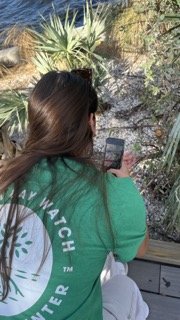Using Apps to Explore and Protect Tampa Bay’s Biodiversity
Using technology to make species identification easier.
by Maria Kershner
Imagine you’re taking a walk at a nearby park or beach and come across an unfamiliar plant or animal. With a quick snap of a photo on your smartphone, you can not only identify the species but also contribute to important scientific research. Applications like iNaturalist, Seek, and iSeahorse allow anyone to become a citizen scientist by helping track species and supporting conservation efforts in the area.
After downloading iNaturalist or using the website, users can upload photos of any plant or animal they encounter. The app takes into account the location of the sighting and suggests possible identifications. Other users can offer their own input, and eventually, a qualified scientist may confirm the identification as "research grade," meaning it can be included in scientific databases. The app also allows users to see the findings of others nearby, creating a community of nature enthusiasts and scientists working together.
Seek, developed by iNaturalist, is a similar app that uses AI to provide quick identification suggestions based on photos or live footage. It’s designed to be user-friendly and is particularly great for kids and beginners. Unlike iNaturalist, Seek doesn’t require an account to upload photos, making it perfect for on-the-go exploration.
For those specifically interested in seahorses, iSeahorse is an app dedicated to identifying these fascinating creatures. This is especially valuable in Tampa Bay, where the area is home to the Dwarf and Lined seahorses. Visitors to the Discovery Center can even learn more about Lined seahorses on display. For those who spend time in the water, iSeahorse can help pinpoint seahorse populations, providing scientists with valuable data to assess the health of the Tampa Bay ecosystem.
At the Tampa Bay Watch Discovery Center, preserving biodiversity and educating visitors about the threats to our ecosystems are top priorities. One significant threat is the presence of invasive species, such as the Cane Toad, which is currently featured at the Discovery Center. These toads pose a risk to the local biodiversity in Tampa Bay. Using smartphone apps like iNaturalist and Seek makes it easier to identify species that could be harming the ecosystem, and provides community members with the tools to take responsible action for species management.
With these resources, outdoor exploration becomes not only a fun and informative activity, but also an opportunity to contribute to the preservation of a more biodiverse Tampa Bay!
About the Author:
My name is Maria Kershner-León, and I’m originally from Charleston, West Virginia. I’m currently a senior at The University of Tampa, where I am majoring in Environmental Studies with minors in Marine Biology and Dance. This semester, I am working as an Education Intern at the Discovery Center, where I assist with public programs and am creating informational materials in Spanish to guide Spanish-speaking visitors through the Discovery Center’s exhibits.

